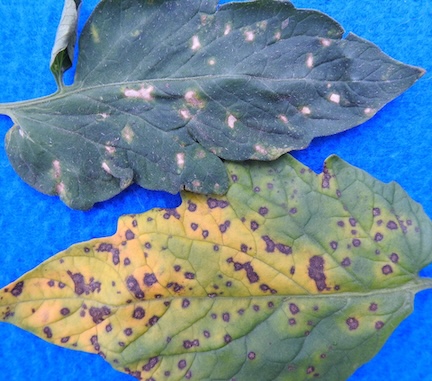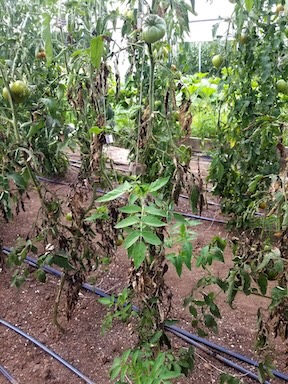
Pest: Stemphylium Gray Leaf Spot of Tomato
Gray leaf spot can be caused by several fungal species in the Stemphylium genus. Stemphylium solani and S. lycopersici are most common in North America, but S. botrysum also causes the disease. Gray leaf spot is typically considered to be most prevalent in humid tropical and subtropical regions, however, the disease was first seen on high tunnel tomatoes on farms in Rhode Island and Connecticut around 2019, and Maine farmers began to share photos of similar symptoms a few years later.

The arrival of gray leaf spot in Maine is likely an aspect of the new climate reality that growers will continue to need to adapt to. Though it likely can’t be tested scientifically, it seems probable that recent summers’ prolonged bouts of higher heat and higher relative humidity — which can also cause elevated temperatures to persist overnight to a greater extent — have allowed this disease to expand the range in which it infects tomato plants and spreads. While we’ve been having summers with these conditions more frequently, the disease can likely only spread so far in a given year, and we may now be seeing overwintering populations that have gradually established themselves further and further north over many seasons.
Pest/disease identification and lifecycle:
Stemphylium infections can start from nearby infected plants; can be seedborne; or, more likely in its gradual spread into Maine, can start from infected crop debris from prior years. Fungal spores produced on living or dead plant tissues spread via splashing rain or irrigation water, or go airborne and travel on the wind in favorable conditions. The disease survives and infects most successfully in relatively hot and wet weather conditions: requiring liquid water or simply high humidity to infect leaf surfaces, and developing most successfully at 77 degrees Fahrenheit. Though petioles and stems can become infected, the disease is mostly noticed on leaves.
Because of the manner in which gray leaf spot presents itself, it may be helpful to think of it as “acting like early blight but infecting like botrytis.” One fortunate difference is that gray leaf spot does not affect tomato fruit the way that early blight or botrytis can. However, that’s likely to be cold comfort if your plant loses all of its leaves. Initial symptoms show up as small dark brown specks, which turn lighter — eventually turning tan to gray in their centers as they enlarge. The centers of these lesions will commonly crack as they begin to dry out. As the disease progresses, the entire leaf may turn gray, dry, and crispy. Early leaf symptoms of Stemphylium gray leaf spot can be easily confused for bacterial leaf spot or Septoria leaf spot (see Fig. 1). The disease development and symptoms of Stemphylium seem, however, to also have many similarities with Alternaria linariae, the disease which causes “early blight” (not to be confused with the more devastating “late blight” caused by Phytophthora infestans and responsible for the great potato famine).

Both gray leaf spot and early blight overwinter on infected crop debris in the soil — spread via splashing water, or from windborne spores from active infections, and tend to progress up an infected plant from the lower leaves towards the upper leaves. The big difference is that early blight requires liquid water to successfully infect leaves, while gray leaf spot can do the same simply with high humidity. Because of this, Maine farmers’ first interactions with this disease were noticing symptoms that looked like early blight but showed up in covered production (i.e., greenhouses or high tunnels) the way that botrytis might — but early blight typically does not. The disease has also been found on tomato plants grown outdoors in Maine.
Damage and crops affected:
The defoliation, described above, is the primary damage caused by this disease, reducing the plant’s photosynthetic potential and also diminishing the affected leaves’ ability to shade fruit and protect it from sun scalding (see Fig. 2).
The three species of Stemphylium responsible for causing gray leaf spot on tomatoes are capable of infecting other solanaceous crops, like peppers and tobacco, and solanaceous weeds, however, the disease has only been identified on tomato plants in Maine thus far. These species have also been reported to infect cucumbers, lettuce, garlic, cotton, gladiolus, and blue lupine. Because Stemphylium gray leaf spot has only emerged as a potentially serious pest of tomatoes in Maine, so far, there is a possibility that only one of the species is present here, and that it is limited to solanaceous crops.
Management options:
The best strategies for management of gray leaf spot are likely to be multifaceted for many growers.
Cultural:
As with many tomato foliar diseases, any growing practices that facilitate rapid drying, and reduce trapped air around plants will be helpful in limiting initial infection and subsequent spread (e.g., greater plant spacing, and sucker, stem, and leaf pruning). Similarly, other common best practices for organic methods of disease management are also important. Because the disease overwinters on infected crop debris, it will be important to practice good sanitation and crop rotation. Remove or destroy infected tomato crop debris, or at least incorporate it into the soil to speed its decomposition before tomatoes are grown again in the same area. When conditions are still favorable for the disease (i.e., prolonged high humidity or leaf wetness during warmer periods) it will likely still be able to infect susceptible plants, unless a preventative fungicide has been applied.
Luckily, genetic resistance to gray leaf spot can be found in tomatoes that contain a single gene (Sm), which has been traditionally bred from a wild tomato relative into many modern varieties. This means that anyone willing to grow these varieties likely won’t see gray leaf spot infect their crop in the first place. It’s advisable to grow one or more resistant varieties for at least an “insurance portion” of your overall tomato plants, especially if you have already struggled with gray leaf spot showing up in your growing area. Cornell Cooperative Extension maintains a spreadsheet of crop varieties with disease resistances noted, available here.
Organic pesticides (as a last resort):
A copper-based fungicide is likely to be the most effective organic control for home and commercial growers (Cueva is one of many commercial options, and is sold by Bonide for home use under the brand Captain Jack’s Copper Fungicide). Commercial growers may also see some improved control with the addition of Oso (polyoxin D zinc) to their management schedule.
Please note: This information is for educational purposes. Any reference to commercial products, trade or brand names is for information only, and no endorsement or approval is intended. Pesticide registration status, approval for use in organic production and other aspects of labeling may change after the date of this writing. It is always best practice to check on a pesticide’s registration status with your state’s board of pesticide control, and for certified organic commercial producers to update their certification specialist if they are planning to use a material that is not already listed on their organic system plan. The use of any pesticide material, even those approved for use in organic production, carries risk — be sure to read and follow all label instructions. The label is the law. Pesticides labeled for home garden use are often not allowed for use in commercial production unless stated as such on the label.
Authors
Caleb Goossen